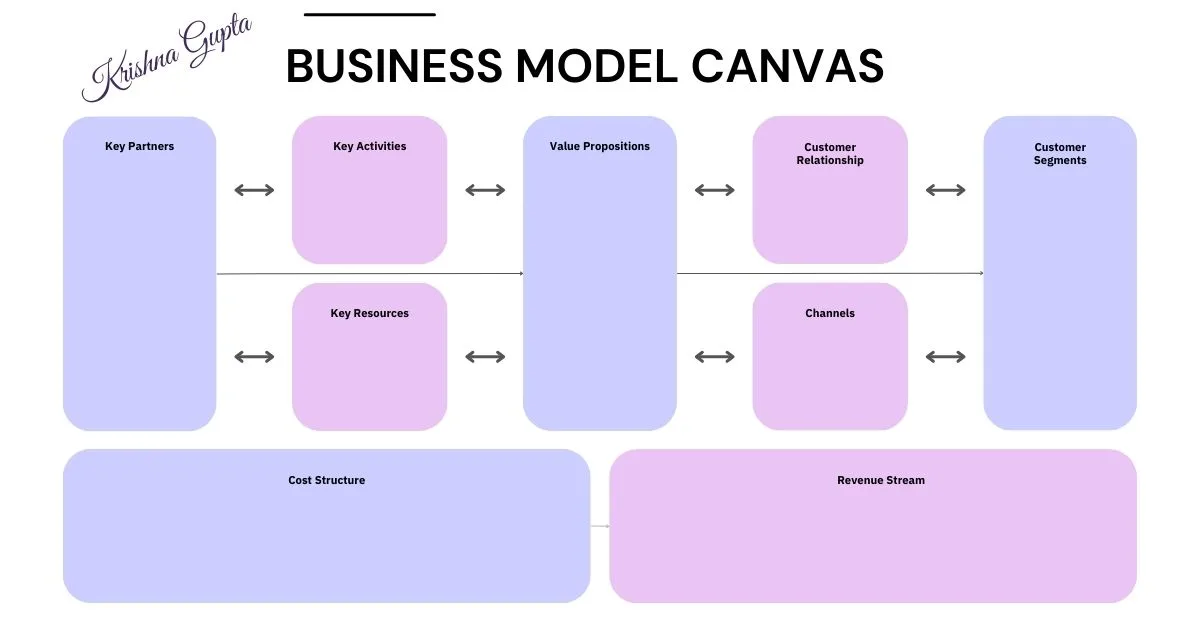Imagine having a visual roadmap that captures the essence of your business, from your customers to your revenue streams. The Business Model Canvas does just that! It’s a powerful tool that helps you visualise, design, and refine your business model, making it easier to understand, communicate, and test your ideas.
Who’s it for?
- Entrepreneurs: Launching a new venture? The canvas helps you brainstorm, validate, and iterate on your business model.
- Established businesses: Looking to innovate or pivot? Use the canvas to explore new opportunities and optimise your existing model.
- Students and educators: Gain a practical understanding of how businesses function.
- Non-profit organisations: Design sustainable models to achieve your social impact goals.
Advantages of the Business Model Canvas:
- Clarity and conciseness: It forces you to focus on the critical elements of your business, leading to a clear and concise overview.
- Communication tool: Use the canvas to communicate your business model effectively to investors, partners, or your team.
- Flexibility and agility: It’s easy to adapt and modify the canvas as your business evolves.
- Strategic planning: Identify potential weaknesses and opportunities in your model, allowing for better strategic planning.
Who should skip the canvas?
- Businesses with complex models: The canvas might be too simplistic for highly intricate operations.
- Solopreneurs with simple models: If your business is straightforward, you might not need the formal structure of the canvas.
- Those opposed to visual tools: If you prefer text-based analysis, the canvas might not be your cup of tea.
Disadvantages of the Business Model Canvas:
- Oversimplification: It can be challenging to capture the nuances of a complex business model on a single page.
- Static representation: The canvas is a snapshot, not a dynamic representation of your ever-changing business.
- Over-reliance on the tool: Don’t let the canvas become a crutch; remember, it’s just a tool to guide your thinking.
Benefits for MSMEs:
- Developing a clear value proposition: MSMEs often struggle to articulate their unique value. The canvas helps them define what makes them stand out.
- Identifying cost-effective channels: Reaching customers can be expensive for MSMEs. The canvas helps them explore cost-effective channels to reach their target audience.
- Building strong customer relationships: The canvas encourages MSMEs to focus on customer needs and build strong relationships.
- Testing and iterating: The flexible nature of the canvas allows MSMEs to test different assumptions and iterate quickly on their model.
In conclusion, the Business Model Canvas is valuable for anyone who wants to understand, refine, and communicate their business model. While it’s not a one-size-fits-all solution, its advantages far outweigh its disadvantages, especially for MSMEs seeking to chart a course to success.
So, grab a canvas and some sticky notes, and prepare to map your path to business success! Remember, the most important thing is to use the tool effectively and adapt it to your needs.
The Business Model Canvas is a visual and strategic management framework that helps entrepreneurs and businesses understand, design, and communicate the critical components of their business model. Alexander Osterwalder and Yves Pigneur developed it, and it is widely used in business planning, innovation, and entrepreneurship.
The Business Model Canvas consists of nine essential building blocks, each representing a crucial aspect of a business:
- Customer Segments: It defines the different segments of people or organisations your business aims to serve. It helps you classify your target customers and their specific needs and preferences.
- Value Propositions: Value propositions are the unique products or services your business offers to meet the needs of your customer segments. This block outlines how your offerings solve customer problems or satisfy their desires.
- Channels: Channels describe how you deliver your value propositions to your customers. This block includes distribution, sales, marketing, and communication channels.
- Customer Relationships: This block covers the relationships you establish and maintain with your customers. Depending on your business model, it can include personalised support, self-service, or automated interactions.
- Revenue Streams: Here, you identify your business’s revenue sources. This block defines the pricing and revenue models, such as one-time sales, subscription fees, or advertising.
- Key Resources: Key Resources are your business’s essential assets and capabilities to operate effectively. These resources include physical assets, intellectual property, skilled personnel, and more.
- Key Activities: Key Activities outline the core functions and tasks necessary to deliver your value proposition. These activities are critical for the functioning of your business model.
- Key Partnerships: This block identifies external organisations or individuals you collaborate with to enhance your business’s capabilities, reduce costs, or access new resources.
- Cost Structure: The Cost Structure defines the various costs of running your business. It includes both fixed and variable costs, as well as economies of scale.
The Business Model Canvas is a visual business plan, often presented on a large poster or canvas, which allows you to see how these nine building blocks are interconnected easily. By filling out each block, entrepreneurs and business leaders can clearly and concisely represent their business model, helping them analyse, iterate, and communicate their strategy. It benefits startups and established businesses looking to explore new opportunities, pivot their existing model, or improve their operations.
